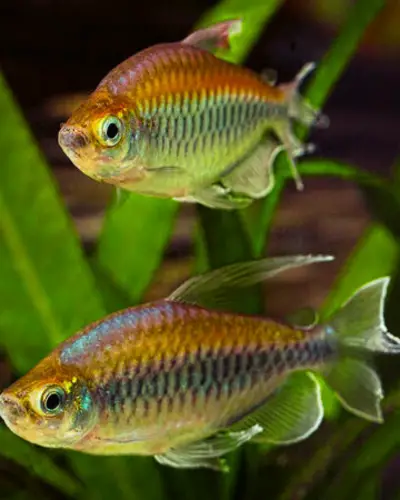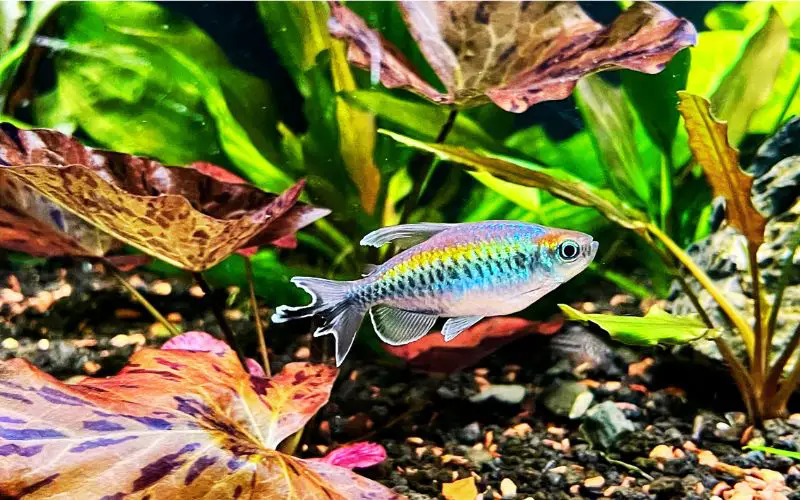What is the Average Congo tetra lifespan? Congo tetras are stunning and vibrant fish popular in home aquariums. With proper care and maintenance, they can live for 3 to 5 years.
As they age, Congo tetras may start to exhibit signs of aging that are important for their owners to recognize to provide the best possible care.
This article will explore the aging signs and symptoms of Congo tetras, including changes in behavior, appetite, and physical appearance.

By understanding these signs, fish owners can ensure that their Congo tetras live happy and healthy lives for as long as possible. Stay tuned to learn more about caring for aging Congo tetras and spotting the signs of aging in these beautiful fish.
Table of Contents
ToggleHow Long Do Congo Tetras Live: Understanding Congo Tetra Lifespan
Congo tetra is a beautiful freshwater fish that hails from the Congo River Basin. They are known for their iridescent colors and peaceful nature, making them popular among aquarium fish enthusiasts. They can live up to 5 years in a well-maintained aquarium with a good diet and proper tank mates.
In the wild, they are often found in schools and prefer plenty of swimming space in their environment. Proper care is essential to ensure they thrive, and they can live up to six years.

When breeding Congo tetras, a minimum tank size of 30 gallons is essential to accommodate their needs. They prefer acidic water with peat moss in the substrate to mimic their natural habitat. Congo tetras are omnivores and can be fed various foods, such as flakes, pellets, bloodworms, brine shrimp, and daphnia.
During breeding, it’s essential to provide them with hiding spots, such as moss or plants at the bottom of the tank. Congo tetras spawn in murky streams, and the young feed on infusoria and baby brine shrimp. They are schooling fish and do best in groups of at least six in a larger tank.
For a complete care guide on the Congo tetra, please provide them with an elongated tank that mimics the stream in the Congo River basin. With the right environment and proper fish food, your Congo tetras will thrive and bring beauty to your fish tank.
What is the Average Lifespan of a Congo Tetra?
The average life span of a Congo Tetra in captivity is around 3 to 5 years. This can be affected by the quality of care they receive, including water quality, diet, and tank mates. You can expect your Congo Tetra to thrive for several years in optimal conditions.
To ensure the longevity of your Congo tetra life span, it is essential to provide them with a well-maintained tank that meets their specific requirements.
They prefer slightly acidic to neutral water with a temperature between 75-80°F. It is best to provide them with a varied diet consisting of high-quality flake or pellet food and frozen or live foods such as bloodworms or brine shrimp.
Congo Tetra Lifespan (Aging Signs and Symptoms)
While Congo Tetras are relatively long-lived fish, their aging process can be subtle and gradual. Here are some signs and symptoms of aging in Congo Tetras:
Physical Changes:
- Fading Coloration: The vibrant red and blue coloration of a Congo Tetra may become duller with age.
- Scale Loss: Older tetras might experience some scale loss, making their skin appear rougher or more patchy.
- Growth Stunted: While not always an aging sign, stunted growth can occur due to poor water conditions or diet, which may affect an older tetra’s size.
- Fin Rot: This is not necessarily an aging sign but can be a symptom of poor water quality, a common issue in aging tanks.
Behavioral Changes:
- Reduced Activity: Older tetras may become less active and rest more.
- Decreased Appetite: Appetite can decline in aging fish.
- Increased Sensitivity: Older tetras might be more sensitive to water quality or temperature changes.
- Difficulty Swimming: An aging Congo Tetra might struggle to swim as well as it used to, showing signs of fatigue or slower movements.
- Social Withdrawal: Some older tetras might withdraw from their tankmates and spend more time alone.
Other Considerations:
- Disease: As fish age, their immune systems weaken, making them more susceptible to diseases.
- Parasites: While not specific to age, parasites can weaken an aging fish.
Caring for Aging Congo Tetras:
- High-Quality Water: Maintain pristine water conditions with regular water changes, a good filtration system, and appropriate temperature.
- Nutritional Diet: Provide a varied diet of high-quality flakes, pellets, and occasional live or frozen foods.
- Stress Reduction: Avoid overcrowding the tank and create a peaceful environment.
- Regular Observations: Monitor your Congo Tetras closely for changes in behavior, appearance, or appetite.
Note: It’s important to remember that individual fish can vary significantly in congo tetras lifespan. Some Congo Tetras might live longer than others, while others might show signs of aging earlier. If you notice any concerning changes in your Congo Tetra’s health, consult a veterinarian specializing in aquatic animals for advice.
Ideal Tank Size for Congo Tetras
The ideal tank size for Congo tetras (Phenacogrammus interruptus) depends on various factors, including the number of fish you plan to keep, their behavior, and their space requirements. Congo tetras are active swimmers and appreciate ample swimming space.
As a general guideline, a minimum tank size of 30 gallons (113 liters) is recommended for a small school of Congo tetras. However, a larger tank is preferable if you plan to keep a larger group or want to provide more swimming space.
A tank size of 55 gallons (208 liters) or larger would be more suitable for a group of 6 to 8 Congo tetras. This larger tank size allows the fish to exhibit their natural behavior and swim freely. Providing a longer tank rather than a tall one is preferable because Congo tetras tend to swim more horizontally.
Remember to consider the tank dimensions as well. A more extended tank with dimensions like 48 inches (122 cm) in length, 18 inches (46 cm) in width, and 20 inches (51 cm) in height would provide a good swimming area for Congo tetras.
Additionally, ensure the tank is well-maintained with appropriate filtration and regular water changes to maintain good water quality. Providing suitable hiding places, plants, and open swimming areas will also help create a comfortable and stimulating environment for the Congo tetras.
What are the Optimal Water Conditions for Congo Tetras fish species?
Congo Tetras are generally peaceful fish that hail from the calm waters of marshes and streams in Africa. Maintaining optimal water conditions is crucial to keeping them healthy and thriving in your aquarium.
Congo Tetras must be kept in water with a wide range of water parameters, including a temperature between 75-80°F and a pH level between 6.0 to 7.5. These fish also appreciate having plenty of aquarium plants to hide in and explore.
Congo tetras are relatively easy to care for regarding feeding. They can be fed various foods, including worms and powdered fish food. Male congo tetra fry can be fed in small amounts several times a day, while female counterparts may benefit from breeding mops to help stimulate cichlid spawning.
Behavior & Tank Mate Compatibility in Captivity
Congo tetra is a beautiful fish species that prefers to be kept in a community tank and is known for its peaceful behavior. The males are more colorful and have longer dorsal fins, which add to their attractiveness in an aquarium setting.
When setting up a new tank for Congo tetras, ample space is essential, as they prefer a minimum of a 20-gallon tank. Adding peat moss at the bottom of the tank can help replicate their natural habitat and encourage breeding behavior.
Congo tetras are known to spawn when a female lays eggs among plants in the tank. A 30-gallon tank is recommended for a larger group to accommodate their active swimming behavior.
When choosing tank mates, selecting peaceful fish compatible with the Congo tetras’ temperament is best.
Commonly Asked Questions about Congo Tetras Lifespan & Congo Tetra Care, Water Parameters (FAQs)
How can I distinguish between male and female Congo Tetras?
Distinguish male Congo Tetras by their vibrant blue bodies and elongated fins. Females are silver-gray with shorter fins and rounder bodies.
How many Congo Tetras are in a 55-gallon?
A 55-gallon tank comfortably houses 20-25 Congo Tetras, providing them with enough space to shoal and explore.
How big does a Congo tetra get?
With their white edging, Congo tetras are a bit bigger than your average tetra! Males grow up to 3 inches (8.5 cm), while females are around 2.75 inches (6 cm). They need a good amount of swimming space in your tank.
Are Congo Tetras active?
Yes, Congo tetras are beautiful and active swimmers! They need a large tank (at least 55 gallons) with plenty of space to zoom around a school.
Why are my Congo Tetras fighting?
Congo tetras fight due to overcrowding, lack of hiding places, or dominance hierarchy competition, especially during breeding season.
Conclusion
In conclusion, the captivating world of aquarium fish never ceases to amaze. From the vibrant colors to the graceful movements, each species brings unique charm to our underwater realms. Among these remarkable creatures is the Congo Tetra, a true gem in the aquatic world. With its iridescent body and elegant fins, it captures the attention of any fish enthusiast.
However, as we delve deeper into the care and keeping of these magnificent fish, we must remember that the Congo tetra lifespan requires our utmost attention. Providing them with a well-maintained habitat, a balanced diet, and a stress-free environment ensures that the Congo Tetra thrives and lives a long and fulfilling congo tetras life span. So, if you’re considering adding this stunning species to your aquarium, prioritize their longevity and give them the care they deserve. Discover the wonders of the Congo Tetra and embark on a journey of beauty and wonder.
Recommended posts
- Congo Tetra Male Vs Female: Identifying Gender & Best Ratio!
- TOP 7 Best Congo Tetra Tank Mates: (A Comprehensive Guide)
- Congo Tetras Size Does Matter? Freshwater Fish Aquarium Tips!
- Congo Tetra Fish Care 101: (A Comprehensive Care Guide)
- Cherry Red Congo Tetra 101: (What You Need to Know!)
- The Basics of Congo Tetra Breeding: A Step-by-Step Guide
- The Congo Tetra Minimum Tank Size: (A Comprehensive Guide)
- The Ideal Congo Tetra Water Temperature: (Complete Beginner Guide)
- Blue Eye Congo Tetra 101: An Overview of This Stunning Fish
- Stunning Congo Tetra Albino Fish: A Comprehensive Care Guide




